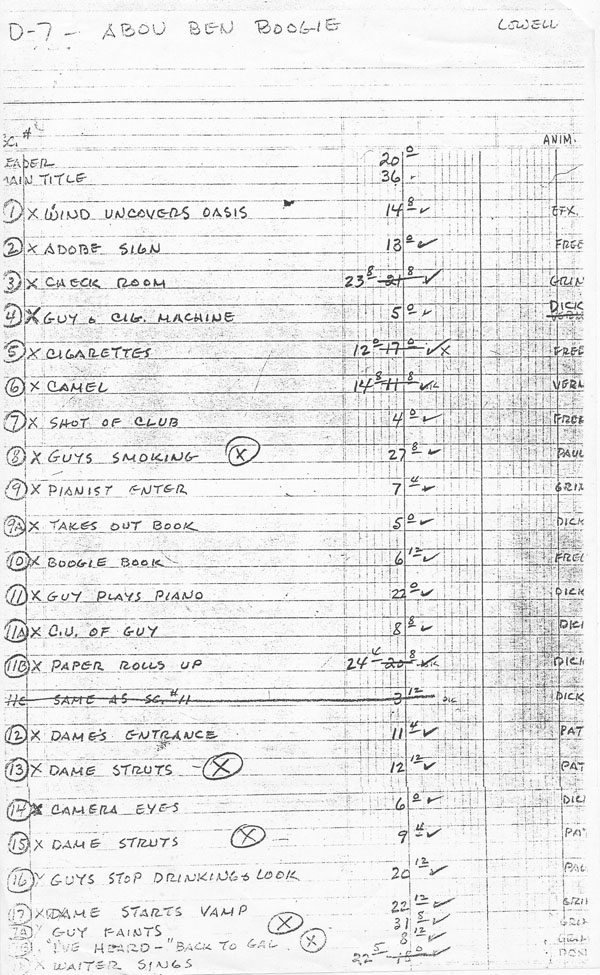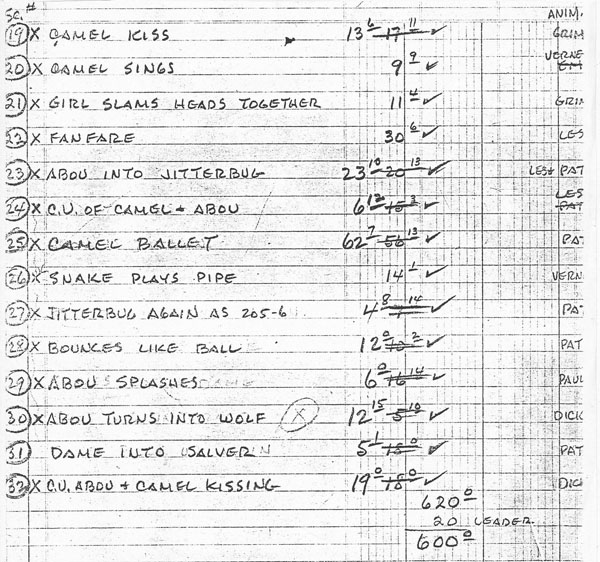
We’re shaking things up this time with a very popular Walter Lantz Swing Symphony!
Director Shamus Culhane’s keen sense of design, cutting, timing and characterization at the Lantz studio gave their output a large step in quality, far ahead of what Alex Lovy and Walter himself achieved when they directed during the early forties. The Swing Symphonies – a more contemporary pastiche on Disney’s Silly Symphonies – was Culhane’s chance to give it his all, presenting a quick, energetic style to the Lantz product.
Although he considered the music to be “junk,” Culhane was prepared to receive an education about jazz from Lantz’s musical composer, the overlooked Darrell Calker. Like Fleischer’s Betty Boop and Screen Songs, the Swing Symphonies often showcased popular jazz performers, such as trombonist Jack Teagarden (Pied Piper of Basin Street) and pianist Bob Zurke (Jungle Jive) whom Calker knew personally.
Animators Grim Natwick, Les Kline, Verne Harding, Paul Smith, Don Williams, Emery Hawkins, and Pat Matthews, among others who didn’t participate in this cartoon, were part of the sole unit of artists. Other West Coast studios had several units, since they had more than one or two directors. Dick Lundy became a director later on, beginning with the last Swing Symphony, Sliphorn King of Polaroo (also featuring Jack Teagarden). All Lantz animators mentioned received credit for their work, albeit on a rotating credit system, so there are not any “unknown” animators in this cartoon.
Culhane’s Abou Ben Boogie is a successor to his earlier Middle Eastern Swing Symphony The Greatest Man in Siam. Both were clearly derivative of Tex Avery’s colossal M-G-M hit Red Hot Riding Hood. Genuine “sexy gal” animation is long gone, but it’s nice to witness Natwick and Matthews’ mastery of natural feminine movement without the aid of rotoscope or live-action reference for “Miss X” (whose singing voice was provided by radio/nightclub singer Patricia Kay). The timing of Don Williams’ waiter and Matthews’ jazzy camel ballet are also brilliant in their execution.

Alas, the Lantz studio was not without its weaknesses. The animation’s clean-up work is not very careful. Note the close-up of the hat check girl (animated by Natwick); her features tend to slide away from her face. In scene 17, Miss X’s lips float around under her nose (reused from an earlier shot).
The draft is confusing in terms of scene numbering and artist assignments. Curiously, most of the scene numbers are not listed as individual shots, but as whole sequences (i.e. scenes 3, 8 and 16). That being said, the quick shots that take place before scene 17A – the “thermometer” and “melting” gags – seem to have been added after the draft had been worked out, presumably to accentuate Miss X’s sex appeal.
Notice that some artists have their names crossed off from different scenes. For instance, Verne Harding is credited for the close-up of the camel singing (scene 20). This was originally bestowed to the great Emery Hawkins. However, the scene fits more into Hawkins’ timing than it does Harding’s. Scene 23, with Abou and Miss X’s first meeting, is credited to both Les Kline and Pat Matthews. Once they start to jitterbug, it seems to switch to Matthews, as the work does not match Kline’s drawing of Abou.
When comparing the film to the draft (below) you’ll note it deviates from the draft at times, given how it is planned, but offers an idea of the Lantz artists’ capability under Culhane’s skillful direction.
First – here’s the film with animators identified with their scene:
Second – here’s the original draft:


Thanks to Mark Kausler, Chase Pritchard, Keith Scott, Jerry Beck and Frank Young for assistance.


 DEVON BAXTER is a film restoration artist, video editor, and animation researcher/writer currently residing in Pennsylvania. He also hosts a
DEVON BAXTER is a film restoration artist, video editor, and animation researcher/writer currently residing in Pennsylvania. He also hosts a 





















































































With both Culhane and Art Heinemann coming over from the Chuck Jones unit at Warners, along with the Avery influences some of the secondary characters and movement in the cartoon have a very Jonesian flavor to them. (the song, meanwhile, is credited to Tot Seymour and Vee Lawnhurst, who were back east a few years earlier working with Sammy Timberg and music for the Max Fliescher cartoons. Quite a bit of a difference between Miss X’s song here and Bluto’s number in “Ali Baba”).
If this issue from the Film Daily published back in Jan 12. 1944 is to be believed:
“Lantz also has ambitious plans for “Miss X”, his newly-created who will first be seen in THE GREATEST MAN IN SIAM.”
Apparently Lantz had many more cartoons with Miss X in mind but something happened that made him change his mind.
Hay’s office sent a wire? They were typically resistant to any “sexy girl” animation at the time.
I think the big plans for “Mrs. X” had much to do with the overseas US militia’s desire for such escapism.
INFO UPDATE: Radio actor Dick Nelson provides the voice of the man practicing his boogie-woogie lessons (“Uncanny device, isn’t it?”).
[Thanks to Keith Scott for that info!]
Does anyone know who the voice of the camel is?
The camel’s voice reminds me of:
Johnnie “Scat” Davis of “Hollywood Hotel” fame (Warner Bros., 1937), whose voice is also heard in the 1938 Looney Tune “Katnip Kollege”.
https://www.youtube.com/watch?v=_fIVoh8KGDI
https://www.youtube.com/watch?v=bJFwZqSw_CU
Ziggy Talent, the novelty singer with Vaughn Monroe’s Orchestra.
https://www.youtube.com/watch?v=XCItxyiIxQQ
To most of us, this cartoon is known more for the fact that it was rejected for “The Woody Woodpecker Show” (1957, ABC) because of the “sexy dancer”. It’s nice to see it for once.
Darrell Calker might have bee the most jazz-oriented of the cartoon scorers. He had played banjo with Boyd Senter’s tourig group in 1929 (and had recorded with same for Victor that year), and had played guitar on several sessions that Vic Berton did for Vocalion in 1935. He may have arranged these as well, but that’s purely conjecture.
Another cartoon man with a jazz connection was Warners’ sound-effects guru Tregoweth “Treg” Brown. Brown played guitar on several Red Nichols sessions in 1930 and 1931, and even sang a line on one side (“The Sheik of Araby”), only to be interrupted by Jack Teagarden, who proceeds to demonstrate how a New Orleans sheik does his thing.
No doubt Art Heinemann brought over to Lantz’s the kind of styling he’d used in pictures like “Case of the Missing Hare” (flat colors for backgrounds, stylized settings, etc.) just as he would later take it to UPA. (Not just in these middle-east fantasies, but in Woodys like “Ski For Two” and “The Beach Nut.”) This heretic has always felt though that Dick Lundy did a hell of a lot more than Culhane ever did to class up the Lantz cartoons; perhaps because he may not have felt quite so much like he was “slumming”? (A common syndrome with ex-Disney men…)
Dick Nelson of course also turned in a dandy narration job for Lantz years later as John, the vaudevillian pooch in “Broadway Bow-Wows” (or to use its Castle Films alias, “Vod-e-vil Daze.”)
At about 2:50 we get a shot where they’re obviously hiding the girl’s figure out of frame. Was this a bit of post-production cropping or did they shoot it that way to avoid trouble?
The lens reflection on those tight shots, along with huge cell scratches, tells me the camera moved in really close. Maybe those were reshot when somebody decided Miss X was a little too well animated. Could the full-on version still exist somewhere on a reel sent abroad “for the boys?”
Is this the same Arthur Hienemann that later became a writer….and wrote some scripts for STAR TREK? I had always assumed they were different people, but I recently learned that the writer had worked for Disney on Fantasia as an artist .
Wow, so Les Kline animated Abou’s epic take (4:52)! I thought it was all Matthews!